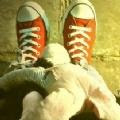
In writing and typography, a ligature occurs where two or more graphemes are joined as a single glyph. Ligatures usually replace consecutive characters sharing common components and are part of a more general class of glyphs called "contextual forms" where the specific shape of a letter depends on context such as surrounding letters or proximity to the end of a line.

History
At the origin of typographical ligatures is the simple running together of letters in manuscripts. Already the earliest known script, Sumerian cuneiform, includes many cases of character combinations that over the script's history gradually evolve from a ligature into an independent character in its own right. Ligatures figure prominently in many historical scripts, notably the Brahmic abugidas, or the bind rune in Migration Period Germanic inscriptions.
Medieval scribes, writing in Latin, increased writing speed by combining characters and by introduction of scribal abbreviation. For example, in blackletter, letters with right-facing bowls (b, o, and p) and those with left-facing bowls (c, e, o, d, g and q) were written with the facing edges of the bowls superimposed. In many script forms characters such as h, m, and n had their vertical strokes superimposed. Scribes also used scribal abbreviations to avoid having to write a whole character at a stroke. Manuscripts in the fourteenth century employed hundreds of such abbreviations.
In hand writing, a ligature is made by joining two or more characters in a way they wouldn't usually be, either by merging their parts, writing one above another or one inside another; while in printing, a ligature is a group of characters that is typeset as a unit, and the characters don't have to be joined — for example, in some cases fi ligature prints letters f and i more separated than when they are typeset as separate letters.
When printing with movable type was invented around 1450,[1] typefaces included many ligatures. However they began to fall out of use with the advent of the wide use of sans serif machine-set body text in the 1950s and the development of inexpensive phototypesetting machines in the 1970s, which did not require journeyman knowledge or training to operate. One of the first computer typesetting programs to take advantage of computer driven typesetting (and later laser printers) was the TeX program of Donald Knuth (see below for more on this). This trend was further strengthened by the desktop publishing revolution around 1985. Early computer software in particular (except for TeX) had no way to allow for ligature substitution (the automatic use of ligatures where appropriate), and in any case most new digital fonts did not include any ligatures. As most of the early PC development was designed for and in the English language, which already saw ligatures as optional at best, a need for ligatures was not seen. Ligature use fell as the number of employed, traditionally-trained hand compositors and hot metal typesetting machine operators dropped.
With the increased support for other languages and alphabets in modern computing, and the resulting improved digital typesetting techniques such as OpenType, ligatures are slowly coming back in use.


Uppercase
IJ glyph appearing as the distinctive "broken-
U" ligature in
Helvetica rendered by
Omega TeX
 As practice as graphic designer, I think observe is the most important thing to have, as in our daily life, there are so many inconspicuous things that we should pay more attention to, and that we might get something that are pleasantly surprise and unexpected. The little things that are not so important in our life but there are being there for so long and inconspicuous, it just need an observant and conscientious person to find it. Here are some thing that I found are very clever that other people see the faces in our objectified life.
As practice as graphic designer, I think observe is the most important thing to have, as in our daily life, there are so many inconspicuous things that we should pay more attention to, and that we might get something that are pleasantly surprise and unexpected. The little things that are not so important in our life but there are being there for so long and inconspicuous, it just need an observant and conscientious person to find it. Here are some thing that I found are very clever that other people see the faces in our objectified life.
























